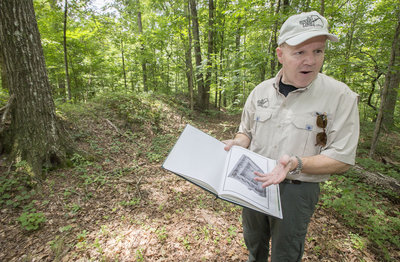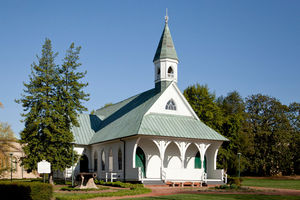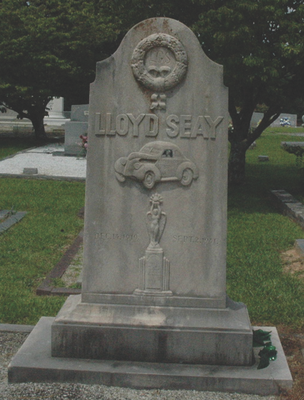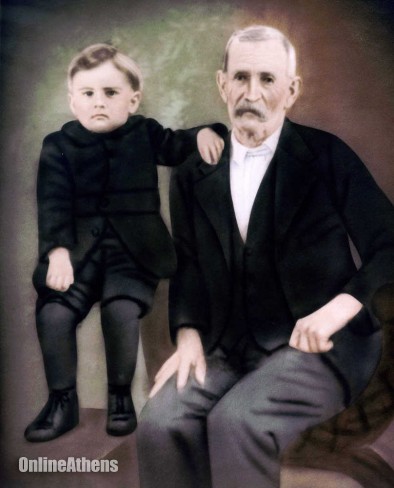GEORGIA: Civil War Battlefield Listed in National Register of Historic Places
The Johnston’s River Line (Boundary Increase and Additional Documentation) and Union Field Fortifications at Henderson Road in Cobb County, Georgia, were listed in the National Register of Historic Places on May 18, 2015. The site, which was the scene of heavy fighting in July of 1864, embodies the distinctive characteristics of the earthworks typical of the latter stages of the Civil War.
Michael Shaffer, a Civil War Historian and member of the River Line Historic Area, talks about the Johnston River Line site in Mableton, which was recently listed on the National Register of Historic Places.
Staff-Kelly J. Huff

Michael Shaffer, a Civil War Historian and member of the River Line Historic Area, talks about the Johnston River Line site in Mableton, which was recently listed on the National Register of Historic Places.
Staff-Kelly J. Huff
This listing consists of two tracts, each of which was nominated separately, that lie within a larger “core battlefield” identified as the southern end of the Chattahoochee River Line. Approximately 65% of the area surrounding the tracts has been developed.
The Johnston’s River Line tract is bisected by Nickajack Creek and is comprised of a series of highly-dissected ridges located immediately west of the Chattahoochee River floodplain. It includes Confederate trenches, an artillery redan, skirmish pits, a rare type of infantry redoubt known as a Shoupade, as well as a Federal artillery battery, and associated skirmish pits.
This portion of the Confederate works constitutes the southern-most extension of Johnston’s River Line, which stretched north to cover the crossing at Howell’s Ferry. The Union Field Fortifications at Henderson Road tract is located 1,500 meters to the north of the Johnston’s River Line tract. It includes Federal artillery batteries and trenches along the crest of an unnamed ridge immediately west of Nickajack Creek.
The Chattahoochee River Line was the scene of heavy artillery duels and constant skirmishing from July 5 through July 10, 1864 between the Army of the Tennessee, the Army of the Ohio, and the Army of the Cumberland (98,000 men under the command of General William T. Sherman), and the Confederate Army of Tennessee (66,000 men) under the Command of General Joseph E. Johnston. Construction of the Chattahoochee River Line under the orders of General Johnston began in June 1864 as General Sherman’s combined armies approached from the northwest.
On July 5, Confederate troops under the command of General John Bell Hood entered the works, located on the Johnston’s River Line tract. Later that afternoon, Federal artillerists of Battery D, First Illinois, set up roughly 500 meters south of Hood’s troops on the south side of Nickajack Creek and initiated counter-battery fire, enfilading the Confederate line in the process.
A Southern general noted that the incoming fire was “rapid…and well directed…throwing many of their shot through the embrasures.” Hood’s cannon were effectively suppressed and ceased firing. Artillery duels punctuated by sporadic small arms fire took place all along the line until July 9.
It was likely on or around this date that Union earthworks, including two artillery redans, were constructed on the tract being nominated as the Union Field Fortifications at Henderson Road, as Federal troops began their direct assault on this portion of the Chattahoochee River Line.
On July 8-9, Sherman’s cavalry troopers crossed the river at several locations and began an incursion in force. By the end of the day on July 10, seven regiments of Federal troops had surrounded the now-abandoned Confederate works. The Federal victory compelled Johnston to pull his troops back into Atlanta, thereby depriving him of the mobility necessary to sever Sherman’s supply line, and sealing the city’s fate.
The National Register of Historic Places is our country’s official list of historic buildings, structures, sites, objects, and districts worthy of preservation.
The National Register provides formal recognition of a property’s architectural, historical, or archaeological significance. It also identifies historic properties for planning purposes and insures that these properties will be considered in the planning of state or federally assisted projects.
National Register listing encourages preservation of historic properties through public awareness, federal and state tax incentives, and grants. Listing in the National Register does not place obligations or restrictions on the use, treatment, transfer, or disposition of private property.
The Historic Preservation Division (HPD) of the Georgia Department of Natural Resources serves as Georgia’s state historic preservation office. Its mission is to promote the preservation and use of historic places for a better Georgia. HPD’s programs include archaeology protection and education, environmental review, grants, historic resource surveys, tax incentives, the National Register of Historic Places, community planning and technical assistance.
The mission of the Department of Natural Resources is to sustain, enhance, protect and conserve Georgia’s natural, historic and cultural resources for present and future generations, while recognizing the importance of promoting the development of commerce and industry that utilize sound environmental practices.
# # #
GEORGIA: City Hears Plans for Historic Cemetery Designation
DAWSONVILLE, Ga. — The city of Dawsonville recently heard a presentation by the Georgia Mountains Regional Commission to turn a local cemetery into a historic area.
The GMRC presented plans to inventory and label the 1.5 acre historic Dawsonville Cemetery and add it to a registry and database for tourism.
“This plan has been in talks for almost two years,” said Joe Rothwell, GMRC regional planner. “When we first started talking about this [with the city], we explored a number of avenues to fund it. We finally came to the conclusion that it would be best suited as a partnership with community affairs, which does not come as a cost to the city.”
According to historical records found by Rothwell’s team, the land originally belonged to Henry Howser, the owner of the local mill.
Howser, who is buried in the cemetery, transferred deed of ownership to the city of Dawsonville in 1891.
His son, who died in the Civil War, was the first person buried in the cemetery.
Other notable graves include 12 civil war veterans, nine World War I veterans and 19 World War II veterans, five Korean War veterans and two Vietnam veterans.
The cemetery is also home to the grave of 1941 National Stock Car Championship winner Lloyd Seay.
“We had 47 individuals that were in the military that are buried out there,” said Dawsonville Mayor James Grogan. “That’s a pretty good number for a town [with a population] of 368 back in the 1960s.
GMRC has worked with the city to prepare the groundwork for this project, having already mapped out the cemetery using satellite imagery and GPS units to input the data into a geographic information system (GIS).
“We used several units to gather … points for each headstone … to get an accurate location,” said Caleb Davis, who led the team that plotted each grave in the cemetery. “We also took a digital photograph of each headstone as well as the grave plot that corresponds to each GPS point.”
GMRC collected nearly 800 GPS points in the cemetery.
“It’s another thing for people to come to Dawsonville to see,” Grogan said. “We have 14 Civil War veterans alone, which is pretty substantial for a small cemetery.”
The city took no action regarding the plans during its June 1 meeting.
–dawsonnews.com
###
LOUISIANA: Civil War Monument Turns 150
LAKE CHARLES, La. — The date was June 3, 1915 and the occasion was to dedicate a 50th anniversary memorial to those in Calcasieu Parish who died in the United States Civil War. Historian Mike Jones says the marker was put up by well-known Lake Charles families.
“The first World War was going on in Europe,” said Jones. “It was put up in a spirit of reconciliation between the north and the south. There were Union and Confederate veterans at the ceremony.”
The dedication for this marker 100 years ago in front of the courthouse was a pretty big deal. Photos from that day show no trees surrounding the courthouse. School kids were let out for that day. Members of the Sons of the Confederacy say this marker is often misunderstood as a sign of racism. However, Andy Buckley says it was originally put up to heal wounds from the past.
“Their ceremony was designed around the theme of reconciliation and healing,” said Dr. Andy Buckley, Commander of the local Sons of Confederate Veterans, Captain James W. Bryan Camp 1390. “The ceremony was designed to bring the community together. Black, white. Because there were a number of free men of color that fought.”
Texas Representative James White, an African American member of the Sons of Confederate Veterans, will deliver the keynote address at a 100th Anniversary ceremony Saturday, June 13 at 10 a.m. on the courthouse lawn.
The commemoration ceremony takes place Saturday morning at 10 in front of the courthouse on Ryan Street in downtown Lake Charles.
###
GEORGIA: Son of Confederate Soldier to be Buried in Eberton
Elberton, Ga. — A color guard with the Sons of Confederate Veterans attended the funeral in Elberton for a man who literally was a son of a Confederate solder.
H.V. Booth, 96, who died Sunday, was the son of Isham Johnson Booth, who served as a guard at the notorious Andersonville prison camp in Georgia. When Booth was born his father was 72 years old and his mother was 38.
Booth learned in April he had incurable cancer, his grandson Clay Booth of Elberton said Tuesday.
“He enjoyed talking about his father,” the grandson said. “He was proud of his heritage.”
Over the years, several newspapers carried stories about Booth, who was the last living son of a Confederate soldier in the state. Nationwide, there were almost 30 sons of confederate veterans alive in 2011, but today there are only four with the passing of Booth, according to the SCV national headquarters in Columbia, Tenn.
During his life, Booth once owned and lost a Ford dealership in Royston.
He was also a war veteran, serving with the U.S. Navy during World War II aboard a landing craft in the Pacific, where he participated in such battles as Guam, Iwo Jima and Okinawa.
“That’s really dangerous duty and he did four invasions,” said Michael Landree, the executive director of the SCV and a recently retired U.S. Marine.
Booth lived most of his life in the Vanna community of Hart County.
In an interview with the Banner-Herald in 2011, Booth said his father pledged never to return to the prison camp, which today is a national historic site.
But in 1931, just three years before he died, he made a return visit to the place where he guarded Union prisoners.
H.V. Booth was widowed twice, and he outlived both of his sons.
The funeral for the war veteran is at 11 a.m. today at Berry Funeral Home in Elberton.
–onlineathens.com
###
VIRGINIA: Confederate Memorial Chapel Begins to Operate Under VMFA Control
The Confederate Memorial Chapel has begun to operate without involvement by the Sons of Confederate Veterans, whose lease on the building expired May 31.

Confederate Memorial Chapel is one of two surviving buildings from the time when a home for Confederate veterans operated at the eventual site of the Virginia Museum of Fine Arts.
The Virginia Museum of Fine Arts and state Department of General Services declined to renew the lease to Lee Jackson Camp No. 1, SCV, instead offering the group a space use agreement.
The Lee-Jackson Camp rejected that agreement in a letter hand-delivered Monday to the office of Alex Nyerges, VMFA director. Nyerges had written on May 27 that a signed agreement should be returned by June 8 “if the Camp is interested in using the Chapel in the future.”
Since June 1, the chapel has been open daily from 10 a.m. to 4 p.m., about 18 hours more each week than the 11 a.m. to 3 p.m. schedule the SCV had maintained Monday through Saturday. A VMFA security guard is stationed in the building. On Tuesday, more than a dozen people had visited before 11 a.m.
SCV members are welcome to visit as members of the public, and there’s no limit on how long they can stay, but they no longer have a key to open the building.
VMFA plans to train docents to offer interpretation of the building, said Pryor Green, VMFA spokeswoman. Meanwhile, the museum has provided information sheets with some details on its history.
The SCV said in its June 8 letter that the suggested space use agreement is contrary to the 2010 lease instructions for the parties “to seek to negotiate a further lease.”
“As a consequence, the Camp will operate as a holdover lessee pending negotiations for a new lease,” wrote Peter Witt, commander of Lee-Jackson Camp No. 1.
Brian Coy, spokesman for Gov. Terry McAuliffe, said the state does not consider the SCV to be a holdover lessee. Since the group did not sign the use agreement by the deadline, it lost the preferential right to have events there, he said. The state will begin to consider requests from other interested parties.
The SCV had occasionally allowed weddings and services to be held in the chapel, at a cost of about $1,200 for each event, which was used for projects at the chapel, said Harrison Taylor, chairman of the SCV chapel committee.
“I might add that we are not in favor of the VMFA holding weddings in the chapel,” he said. “The sole purpose of the wedding activity was to generate funds to support the mission of the chapel as a memorial to the Confederate dead.”
The VMFA has several areas that can be rented for wedding receptions at a fee of $2,500 to $7,500, plus security costs of $750 an hour. It has not yet established a usage fee for the chapel, Green said.
–timesdispatch.com
###




